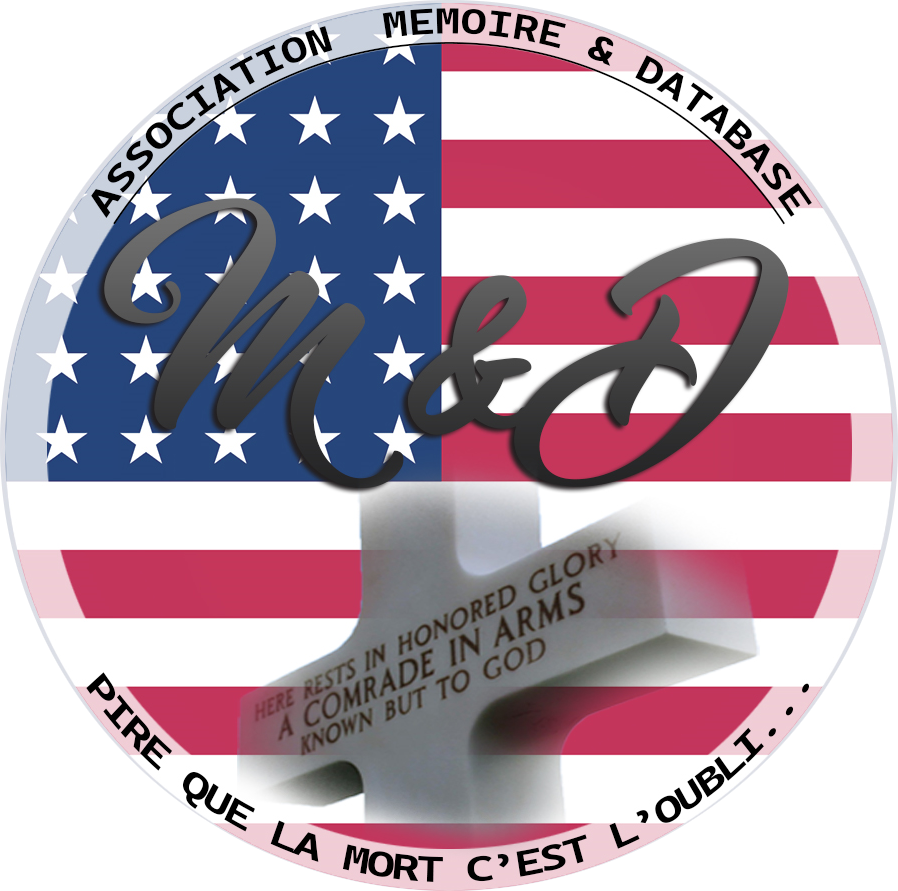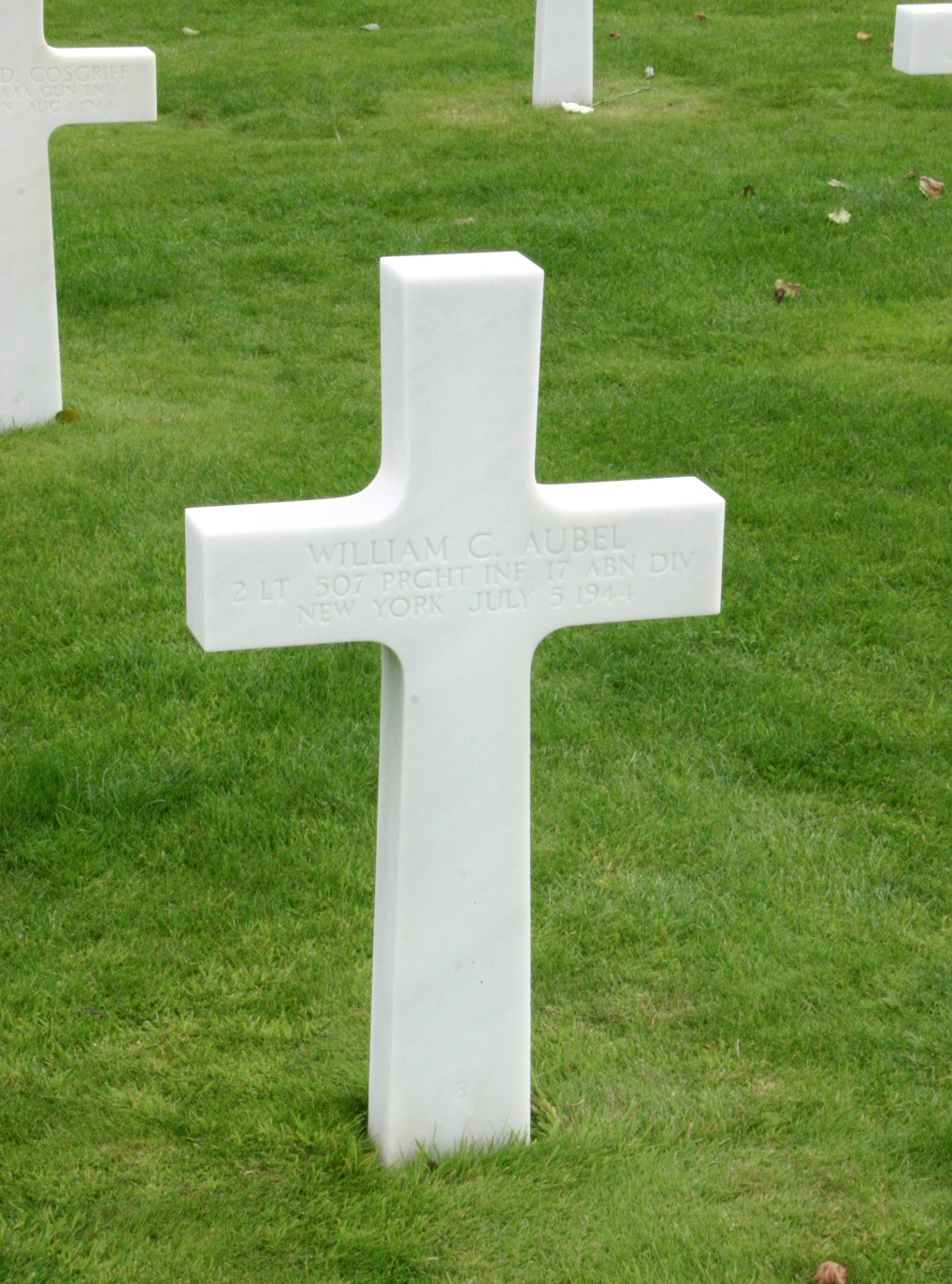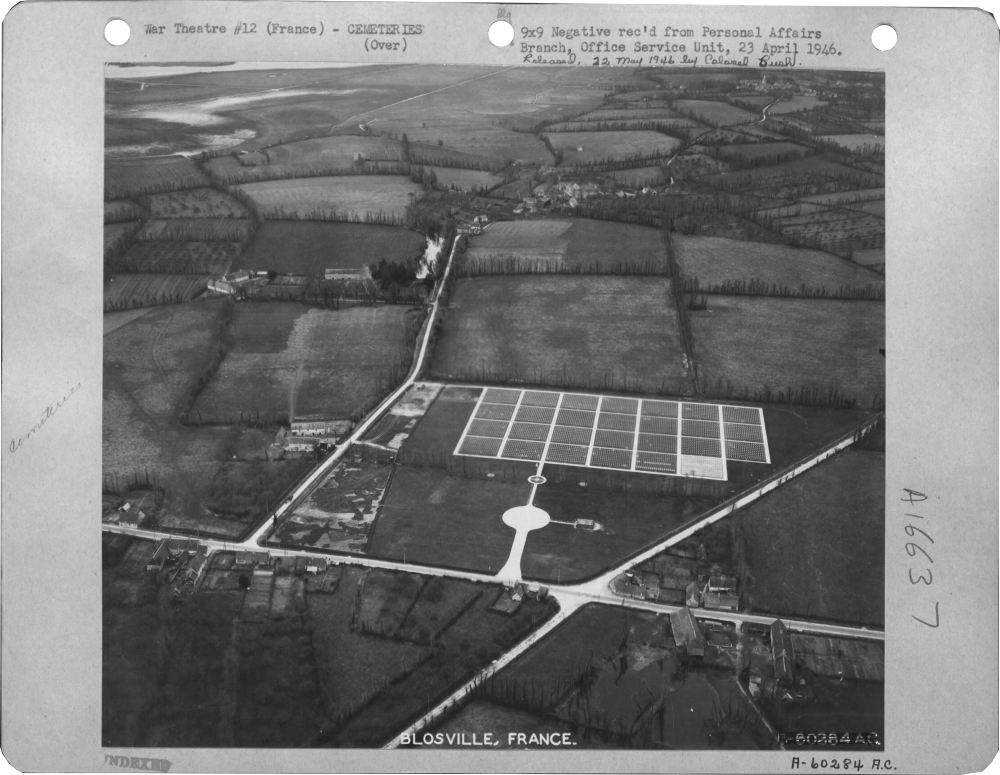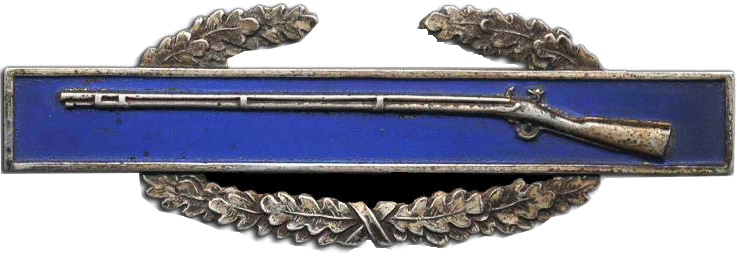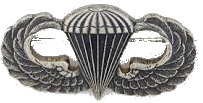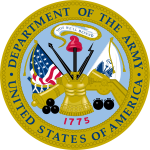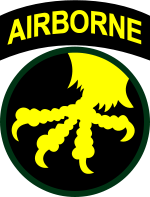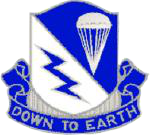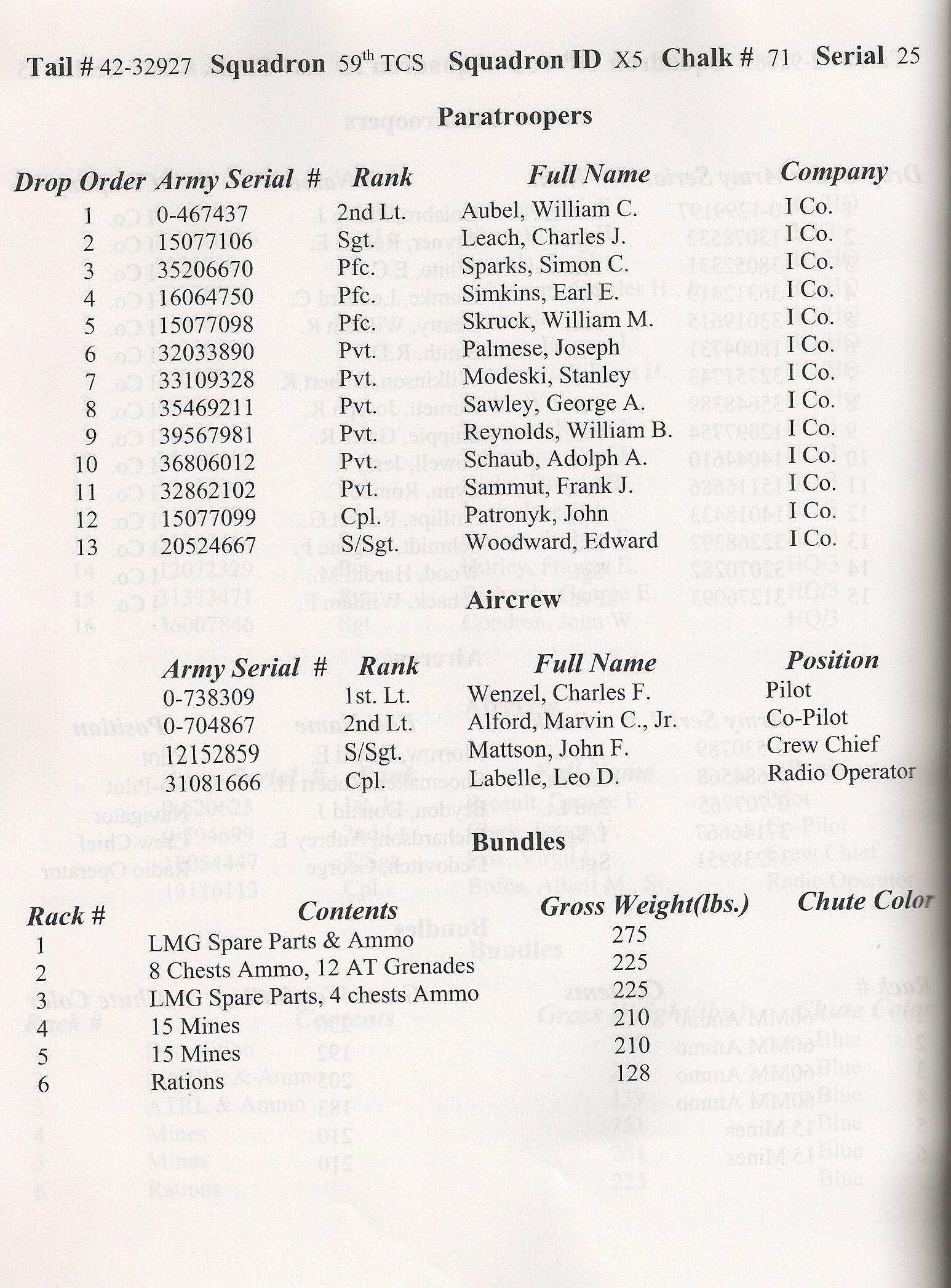|
William Crowther AUBEL
| ||||||||||||||||||||||||
|---|---|---|---|---|---|---|---|---|---|---|---|---|---|---|---|---|---|---|---|---|---|---|---|---|
|
Source : JF Pellouais (Ellen Marchese)
| ||||||||||||||||||||||||
| NUMBER OF SERVICE | O-467437 | |||||||||||||||||||||||
| AGE | 24 yo | |||||||||||||||||||||||
| DATE OF BIRTH | 24 December 1919 | |||||||||||||||||||||||
| ENLISTMENT STATE | NEW YORK | |||||||||||||||||||||||
| FAMILY | Single | |||||||||||||||||||||||
| RANK | Second Lieutenant | |||||||||||||||||||||||
| FONCTION | Paratroopers | |||||||||||||||||||||||
| JOB BEFORE ENLISTEMENT |  | |||||||||||||||||||||||
| DATE of ENLISTEMENT | ||||||||||||||||||||||||
| COMPANY | Company I | |||||||||||||||||||||||
| BATTALION | 3rd Battalion | |||||||||||||||||||||||
| REGIMENT | 507th Parachute Infantry Regiment | |||||||||||||||||||||||
| GROUP | 17th Airborne Division | |||||||||||||||||||||||
| DATE OF DEATH | 5 July 1944 |
Source : F Lavernhe | ||||||||||||||||||||||
| STATUS | KIA | |||||||||||||||||||||||
| PLACE OF DEATH | La POTERIE - Colline 95 | |||||||||||||||||||||||
| CEMETERY TEMPORARY |
CEMTERY TEMPORARY of Blosville N°3508
| |||||||||||||||||||||||
| CEMETERY | NORMANDY AMERICAN CEMETERY of Colleville | |||||||||||||||||||||||
| GRAVE |
| |||||||||||||||||||||||
| DECORATION |
| |||||||||||||||||||||||
| ||||||||||||||||||||||||
| STORY | ||||||||||||||||||||||||
|
Son of Verne and Nancy Belle Aubel, William is originally from Pennsylvania and has the eldest of a sister. He lived in Onondaga County, New York State when he joined the airborne troops and a new regiment created in July 1942 the 507th P.I.R.. He joined Fort Benning until March 1943 where he trained there and was certified. In this month of March, the regiment moves to Louisiana for major maneuvers with the Third Army. Then he joined Nebraska where he made tactical jumps. Until the beginning of September, maneuvers and presentations punctuate the activity. In September, the regiment went to bivouac at Stockdale Lake to rest. At the end of October the regiment arrives at Camp Shanks in the state of New York. On December 3 the regiment leaves the camp; on December 5, he boarded the SS Strathnaver which took him to the European continent, to England. After 11 days of crossing the 507th arrives in Liverpool, from there it takes a train for Scotland and a Libertyship for Ireland. On January 14, 1944, the 507th P.I.R. is attached to the 82nd Airborne Division. On March 11, 1944 the regiment left Ireland for Nottingham in England where maneuvers, night jumps and mass jumps are planned. At the end of May, the third battalion moved to Barkston Heath airfield. After a first postponement of 24 hours, the big night finally arrived on June 5. William is in serial 25 of the Boston mission, his C-47 is piloted by 1st Lt. Wenzel Charles F. of the 59th TCS of the 61th TCG under number 42-32927. William is the jumpmaster of his stick of 13 paratroopers from Company I. After the battles of the first days of June, the 507th received a three-day rest. On June 14, the third battalion and William moved towards the Renouf hamlet to relieve the 90th Infantry Division. On June 16, he established a defensive position on the Franquetot-Baupte line. On June 25, the regiment is in Baupte and is relieved by the 90th Infantry Division. On July 3, the 507th P.I.R. is the vanguard of the Cotentin clearing offensive. | ||||||||||||||||||||||||
| On July 5, the third battalion climbed the eastern flank of Hill 95, positioned in the woods, it suffered German fire, but the paratroopers held their positions on this Pottery hill despite terrible losses, among them William which will fall during these defensive fights which will allow the opening of the liberation of the Haye-du-Puits. |  | |||||||||||||||||||||||
Compagny I |
Plan de Vol | |||||||||||||||||||||||
|
Stick #71 | ||||||||||||||||||||||||
Activated/Activé |
Normandy/Normandie |
| 15 Apr 1943 | Days of Combat/Jour de Combat 45 |
| Casualties/Victimes 6 745 | |
Entered Combat/Entré au combat |
|
| 25 Dec 1944 at Ardennes | |
|
Commanding Generals/Commandants généraux Maj. Gen. William M. Miley (Apr 43 - inactivation)
|
Campaigns/CampagnesRhineland (15 Sep 44 - 21 Mar 45)Ardennes-Alsace (16 Dec 44 - 25 Jan 45) Central Europe (22 Mar 45 - 11 May 45) |
PLAN DE ROUTE DE LA CAMPAGNE - CAMPAIGN ROUTE MAP |
|
 |
|
DIVISION CHRONICLEThe 17th Airborne Division was stationed in the United Kingdom from 25 August to 23 December 1944. From 23 to 25 December, elements of the Division were flown to the Reims area in France in spectacular night flights. These elements closed in at Mourmelon. After taking over the defense of the Meuse River sector from Givet to Verdun, 25 December, the 17th moved to Neufchateau, Belgium, then marched through the snow to Morhet, relieving the 28th Infantry Division, 3 January 1945. The Division entered the Ardennes campaign, 4 to 9 January, at the Battle of Dead Man's Ridge. It captured several small Belgian towns and entered Flamierge, 7 January, but enemy counterattacks necessitated a withdrawal. However, constant pressure and aggressive patrolling caused the enemy to retreat to the Ourthe River. On 18 January, the Division relieved the 11th Armored Division at Houffalize, pushed enemy remnants from the Bulge, and seized Wattermal and Espeler, 26 January. Coming under the III Corps, the 17th turned toward Luxembourg, taking Eschweiler and Clervaux and clearing the enemy from the west bank of the Our River. Aggressive patrols crossed the river to probe the Siegfried Line defenses and established a limited bridgehead near Dasburg before being relieved by the 6th Armored Division, 10 February. A period of reequipment and preparation began. Taking off from marshalling areas in France, the 17th dropped into Westphalia in the vicinity of Wesel, 24 March. Operation Varsity was the first airborne invasion over theRhine into Germany itself. On the 25th, the Division had secured bridges over the Issel River and had entrenched itself firmly along the Issel Canal. Moving eastward, it captured Haltern, 29 March, and Munster, 2 April. The 17th entered the battle of the Ruhr Pocket, relieving the 79th Infantry Division. It crossed the Rhine-Herne Canal, 6 April, and set up a secure bridgehead for the attack on Essen. The "Pittsburgh of the Ruhr" fell, 10 April, and the industrial cities of Mulheim and Duisburg were cleared in the continuing attack. Military government duties began, 12 April, and active contact with the enemy ceased, 18 April. The Division came under the XXII Corps 24 April. It continued its occupation duties until 15 June 1945 when it returned to France for redeployment. |
CHRONIQUE DE DIVISIONLa 17e division aéroportée a été stationnée au Royaume-Uni du 25 août au 23 décembre 1944. Du 23 au 25 décembre, des éléments de la division ont été acheminés par avion vers la région de Reims, en France, lors de vols nocturnes spectaculaires. Ces éléments ont abouti à Mourmelon. Après avoir repris la défense du secteur de la Meuse de Givet à Verdun, le 17 décembre, le 17 décembre, il s’est installé à Neufchâteau, en Belgique, puis a dévalé la 28ème Division d’infanterie le 3 janvier 1945. , Du 4 au 9 janvier, à la bataille de Dead Man's Ridge. Elle a capturé plusieurs petites villes belges et est entrée dans Flamierge le 7 janvier, mais les contre-attaques ennemies ont nécessité un retrait. Cependant, la pression constante et les patrouilles agressives ont contraint l’ennemi à se retirer sur la rivière Ourthe. Le 18 janvier, la division a relevé la 11ème division blindée à Houffalize, repoussé les restes ennemis du Bulge et saisi Wattermal et Espeler, le 26 janvier. Venant du IIIe Corps, le 17ème se tourna vers le Luxembourg en prenant Eschweiler et Clervaux et en dégageant l'ennemi de la rive ouest de la rivière Our. Des patrouilles agressives ont traversé la rivière pour sonder les défenses de la ligne Siegfried et ont établi une tête de pont limitée près de Dasburg avant d'être relevées par la 6ème division blindée, le 10 février. Une période de rééquipement et de préparation a commencé. Décollant des zones de rassemblement en France, le 17 mars est tombé en Westphalie dans les environs de Wesel, le 24 mars. L'opération Varsity était la première invasion aéroportée sur le Rhin en Allemagne même. Le 25, la division avait sécurisé des ponts sur la rivière Issel et s'était fermement retranchée le long du canal d'Issel. Se dirigeant vers l’est, il captura Haltern le 29 mars et Munster le 2 avril. Le 17 est entré dans la bataille de la poche de la Ruhr, soulageant la 79e division d'infanterie. Elle franchit le canal Rhin-Herne le 6 avril et installa une tête de pont sécurisée pour l'attaque d'Essen. Le 10 avril, le "Pittsburgh of the Ruhr" est tombé et les villes industrielles de Mulheim et Duisburg ont été éliminées dans l'attaque continue. Les devoirs du gouvernement militaire ont commencé le 12 avril et le contact actif avec l'ennemi a cessé le 18 avril. La division a été placée sous le commandement du XXIIe Corps le 24 avril. Il a continué ses fonctions d'occupation jusqu'au 15 juin 1945, date à laquelle il est rentré en France pour être redéployé. |
| SOURCE INFORMATION & PHOTO | Armydivs.squarespace.com |
|---|
| SOURCE INFORMATION & SOURCE PHOTO | Findagrave.com - Abmc.gov - Bruno CADEVILLE - Dday-overlord.com |
|---|---|
| PROGRAMMER | Henri, Garrett, Clive, Frédéric & Renaud |


